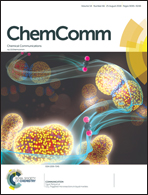Translational opportunities for amyloid-targeting fluorophores
Abstract
Advances in diagnostic medicine have led to an increased awareness and heightened concern for the high prevalence of amyloid-associated neurodegenerative diseases, especially in the elderly. These diseases have characteristic late stage symptoms that often make it possible to distinguish one disorder from another, though methods to diagnose neurodegeneration pre-symptomatically remain a critical challenge. At the molecular level, misfolded protein aggregates known as amyloids are ubiquitously found in many neurodegenerative diseases, and have been suggested to appear before clinical symptoms manifest. Amyloids have, thus, become a valuable potential diagnostic target for chemists, and recent work by many groups have shown that they can be selectively targeted by small molecule fluorescent probes. Here, we summarize some of the exciting work currently under investigation in the area of fluorescence-based amyloid detection and highlight recent efforts to expand the utility of amyloid-targeting fluorophores as clinical tools for disease diagnostics.



 Please wait while we load your content...
Please wait while we load your content...